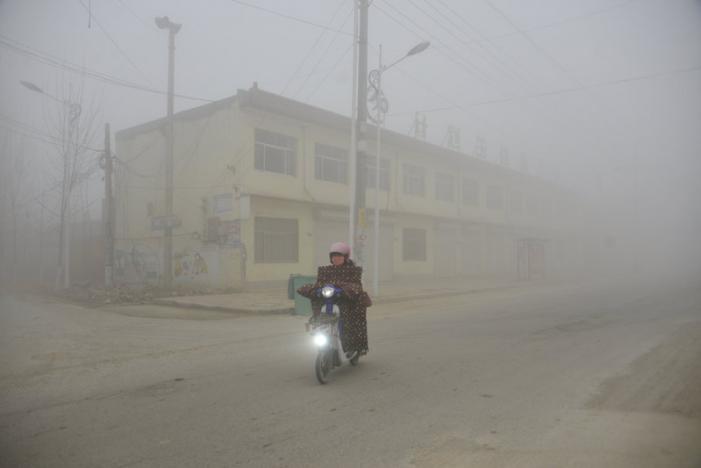
A cyclist rides along a street in heavy smog during a polluted day in Liaocheng, Shandong province, December 20, 2016. Photo: Reuters
Beijing will lift its red alert for air pollution after Wednesday night as cold air is expected to disperse the smog that has lasted for several days.
The red alert, which had been in force since Friday evening, was lifted at midnight, the city’s heavy pollution emergency response headquarters said. It said air quality should “improve markedly” after midday today.
Emergency measures such as car restrictions based on even-odd license plate numbers will end, and kindergartens and schools will resume classes.
China has been engulfed in the worst smog of the year for the past few days and twenty four cities had issued red alerts for dangerously high pollution as of Tuesday..
Northern China was shrouded in pollution for a fifth day on Wednesday, disrupting flights, traffic and shipping, and closing factories and schools, with some residents complaining emergency anti-smog measures were not operating.
Hundreds of government inspectors patrolled Beijing on Wednesday to enforce temporary bans on barbecues and make sure that cars with even number plates were the only ones on the roads. Many Beijing high-rises simply disappeared into the grey haze. Commuters wore face masks as they headed to work.
However, residents in Shijiazhuang, north China’s Hebei province complained that schools there were open even though the city remained on red alert, and media reports in central China's Henan province carried images of students taking exams in the smoggy open air.
"We already don't know how long this smog will last, so why aren't classes being stopped?" a Shijiazhuang resident posted on China's Twitter-like Weibo microblogging service.
"The students are wearing masks every day and attending class in a daze," the post said on Wednesday. Shijiazhuang's education authority issued a notice on Monday saying all classes would be suspended.
The air quality index in the major steel-producing district of Fengnan in Hebei’s Tangshan was still as high as 578 as of yesterday morning. Red alerts are issued when the AQI is forecast to exceed 200 for more than four days in a row, 300 for more than two days or 500 for at least 24 hours.
Concentrations of hazardous breathable particles known as PM2.5 were also at a dangerous level of 360 micrograms per cubic meter in Beijing yesterday, according to official data. The safe recommended level is 10 micrograms, according to the World Health Organization.
China began a “war on pollution” in 2014 amid concerns its industrial past was tarnishing its global reputation and holding back its future development.
But Environment Minister Chen Jining told the meeting that the mix of industries and energy types throughout northern China made pollution a complex, long-term challenge, and clean-up efforts still lacked strength and focus.
The Beijing-Tianjin-Hebei region, known as Jing-Jin-Ji, has been at the forefront of China’s efforts to cut pollution and has pledged to cut emissions of PM2.5 by 25 percent over the 2013-2017 period.
Guo Jinlong, Beijing’s top Party official, said at a meeting on Tuesday that the winter smog could make it harder for the region to meet annual targets. Guo said more work was needed to ensure emergency measures were fully implemented, according to an account of the meeting released by the Ministry of Environmental Protection.
Tonny Xie, director of the Clean Air Alliance of China, said: “China’s long-term clean air vision requires the cleaning up of both the industrial structure and energy structure.
PM2.5 emissions in Jing-Jin-Ji and surrounding regions fell more than 14 percent in the first 10 months of the year, but Xie said the government needs to deploy a “special control strategy” during winter when coal use surges.
The environment ministry has been naming and shaming companies for failing to cut output during bouts of smog, and it has accused local authorities of lapses in monitoring.
Lax enforcement is blamed in other regions, including Shanxi and Inner Mongolia, China’s two biggest coal producers.
“Air quality in the Beijing-Tianjin-Hebei region is influenced by pollution from Shanxi, Inner Mongolia, Shandong and Henan and that’s why the State Council has been coordinating all these provinces,” said Xie.
“Emission control standards should be equally implemented in those regions to avoid the relocation of pollution,” he added.
| Touched | Sympathetic | Bored | Angry | Amused | Sad | Happy | No comment |